| Reviews & Columns |
|
Reviews DVD TV on DVD Blu-ray 4K UHD International DVDs In Theaters Reviews by Studio Video Games Features Collector Series DVDs Easter Egg Database Interviews DVD Talk Radio Feature Articles Columns Anime Talk DVD Savant Horror DVDs The M.O.D. Squad Art House HD Talk Silent DVD
|
DVD Talk Forum |
|
|
| Resources |
|
DVD Price Search Customer Service #'s RCE Info Links |
|
Columns
|
|
|
George Carlin Commemorative Collection
The Collection:
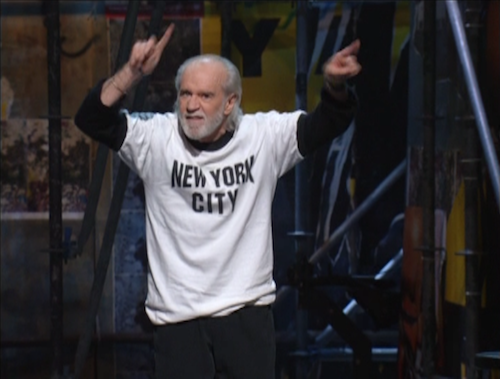
As we remember George Carlin on the tenth anniversary of his passing (June 22, 2008), it will come as a great joy to fans to be able to celebrate George's talent with a new 10-disc multi-format set, George Carlin Commemorative Collection. The set incorporates all fourteen of George's stand-up specials for HBO, several hours of additional television appearances and interviews, the recent posthumous CD I Kinda Like It When a Lotta People Die, and HD versions of his final two specials. It's the definitive George Carlin video collection.
Fans of stand-up comedy already know that George Carlin is often mentioned as one of the top two or three stand-ups of all time. (If George isn't number one, then maybe we give it to the visionary storyteller Richard Pryor, or maybe the anti-establishment soothsayer Lenny Bruce.)
Fans also probably know that George's stand-up has gone through many phases. The first phase, from his start in the late '50s to some time in the late '60s, was, in essence, his "entertainer" phase. He would goof on popular culture, do funny voices, and attempt impressions of famous people. George never necessarily stopped doing this kind of stuff entirely, but as the counterculture grew in prominence, and the '60s became the '70s, George's focus shifted from the funny things people say on television to the "Seven Words You Can Never Say on Television."
In the next phase, George's material became more autobiographical, more observational, more poetic, and more philosophical. The first two impulses are strong in the nostalgic bits from his 1972 Class Clown album (from which the famed "Seven Words" routine originates), while the latter two are obvious in the title track of his 1973 follow-up, Occupation: Foole.
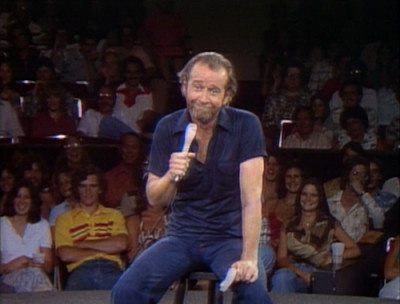
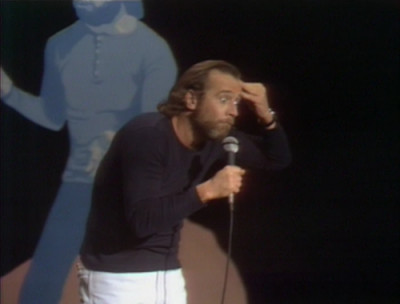
That's the space where we find George during his first HBO special, On Location with George Carlin (1977). The show, recorded in front of a college crowd at the University of Southern California, is looser than most folks would expect a TV stand-up special to be. After a disclaimer about the profanity contained within the special, George is interviewed about his comedy influences. Then when he takes the stage, he riffs for a good two or three minutes before attempting any material. Later, a stagehand comes up and swaps out a faulty microphone, forcing George to dig himself out of the hole created by that energetic lag. Considering the powerhouse that HBO would become in the world of stand-up specials, it's interesting to see both George and the company just casually trying things out in this first effort together.
George does a version of the "Seven Words" routine in On Location, and he continues to do variations on it for the next few specials, redacting and expanding the list with new selections. It makes sense that someone who "thinks up goofy shit," as George claims he does in his second special George Carlin: Again! (1978), would never be satisfied boiling down humanity's complex relationship to language into one 10-minute routine in 1972. Although, by reprising the bit and getting the guaranteed laughs, there is also the vague sense of George resting on his laurels. The choice to shoot the Again special in the round, with the audience on all sides, also feels like a gimmick to goose some extra juice from material that a large chunk of the audience might already know by heart. But... it's arguably a gimmick that works. George's mid-'80s specials blur together for me, but I always remember this one for its look and energy.
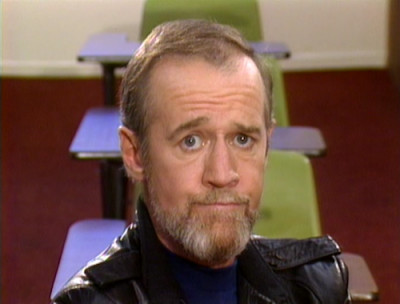
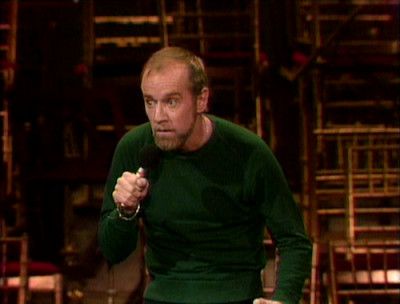
Speaking of those specials, Carlin at Carnegie (1983), was taped after Carlin's second heart attack. The long hippie hair is gone, and a new hardness is visible in George's eyes. His material is still pretty whimsical here, but one catches a whiff of future anger in bits like his argument with his Rice Krispies: "Snap, Crackle, Fuck Him."
Carlin on Campus (1984) opens with George combining phrases from the Lord's Prayer and the Pledge of Allegiance into a prayer for the separation of church and state. Arguably, it's an early version of the poetic word games that George would often use to kick off future sets and an indicator that his mild disillusionment with his Catholic upbringing was starting to change into something more intense. This special is essential, if only because it contains great performances of two of George's best-known routines: the materialism critique "A Place for My Stuff" ("Have you ever noticed that other people's stuff is 'shit,' and your shit is 'stuff?'") and "Baseball and Football," in which George illustrates how the first sport is calm and the second is war-like.
The 1986 special Playin' with Your Head is sometimes characterized as the creative nadir before Carlin rebounded with his "cranky old man" phase. Sure, the special is a little short (padded out by a fake noir short film featuring Vic Tayback that has nothing to do with anything), and thematically, it's kind of scattershot, but George is so damn good at what he does that this one can't be categorized as a miss. There are just too many laughs. In fact, I've read quite a few online rankings of George's specials (including one from my DVD Talk colleague, Oktay Ege Kozak), and I realized that even the specials that were getting dissed by these other writers I've watched multiple times in my life. The weakest George Carlin hour is still better than most comics' best. Not that Playin' with Your Head is my personal least favorite. That one is still to come (and, if you're a Carlin fan, it's probably not the one you're suspecting).
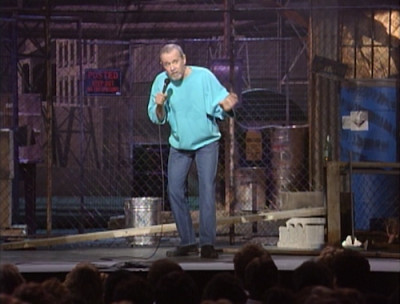
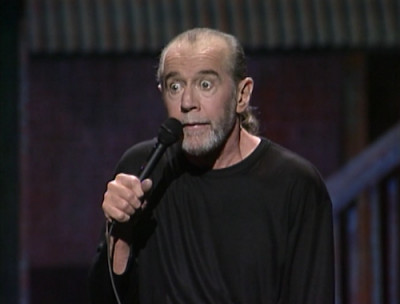
With 1989's What Am I Doing in New Jersey?, George's philosopher-poet persona morphs into something angrier and more aggressive. The energy he once put fully into analyzing the minutiae of everyday interactions he now focuses upon dissecting the hypocrisies of those in power and those who seek power. The Reagan administration and Christian fundamentalists are among the ripe targets he tackles with vicious aplomb. There's still some everyday stuff in there, like a long chunk on driving, but the tone has already changed.
As its title implies, 1990's Doin' It Again might as well just be What Am I Doing in New Jersey? part two (it was even taped in Jersey, although in a different city this time). He continues to rail against the Republicans, but follows up by bashing political correctness and feminists too. There's something to offend and infuriate everyone, which is pretty much true for all of George's specials from here on out. But his analyses of the way language is used to disconnect people from meaning -- such as the way "shell shock" mutates over time into "post-traumatic stress disorder" -- is some of his sharpest, most thoughtful, and most memorable material.
Originally broadcast live in 1992, Jammin' in New York is already widely known as George's favorite of his own specials. It's easy to see why. Angry George is firing on all cylinders, taking aim at the first Gulf War and the military industrial complex, carving up the ill-gotten gains of the rich and powerful and offering it to the homeless (in his imagination, at least), and reframing the intentions of smug do-gooders who want to "save the Earth" by rebutting, "The planet is fine. The people are fucked. ... The planet isn't going anywhere. We are!" He even incorporates some of his old relatable observational humor, but with the explicit purpose of bringing his listeners together, to combat those in power who try to drive us apart. Wow.
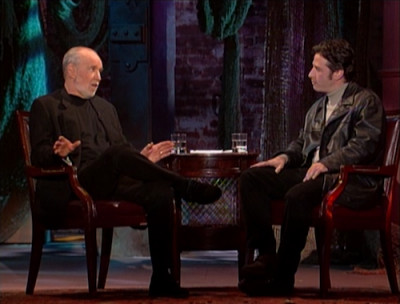
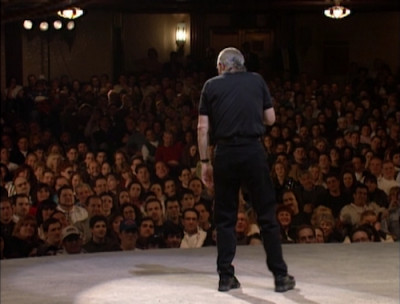
Back in Town (1996) was another live broadcast, and the way George whips around the stage, this might be his most energetic special. Once again, he tackles the corrupt political system, elitist hypocrisy, and the cartoonish excessiveness of American culture. At one point, he dismisses the "sanctity of life," and as if to prove that point, he later envisions a dystopic prison farm, where criminals are allowed to kill each other for the amusement of a national TV audience.
The tenth special in the set is a hybrid of sorts. George Carlin: 40 Years of Comedy (1997) is part career retrospective, part interview, and part regular stand-up show. Hosted by Jon Stewart, each of these three elements of the special go off without a hitch, and the stand-up chunk in the middle is surprisingly generous (roughly a half-hour, much of it unique to this special).
George closed out the '90s with You Are All Diseased (1999), a vitriolic attack on American BS in its various forms: corporate perversions of the counterculture, like Harley Davidson and the House of Blues; advertising and the lies it sells on behalf of corporate greed; and, maybe most viciously, religion and its overwhelming, brainwashing power. Many of these bits hit home, but the long opening chunk about the frustrations and ineffectiveness of airport security acts as a weird pre-9/11 time capsule now; most of George's complaints are irrelevant, now that the TSA demands more and stranger concessions from flyers.
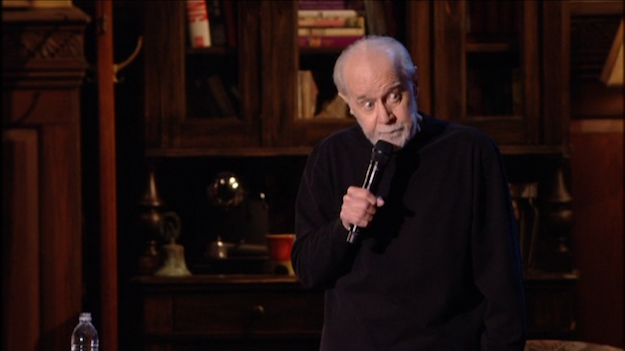
Speaking of 9/11, now we come to my personal least favorite special in the set, Complaints and Grievances (2001). Recorded a little over two months after the terrorist attack on New York City, this set bears the evidence of last-minute changes. The special was originally going to be called I Kinda Like It When a Lotta People Die, a sentiment that would not have worked at the time, but which might have given this special a more coherent focus. Instead, we get scattered rants about the vapidness of American culture. Not bad -- as I already said, nothing in this set is -- but little of the special rises to the level of George's closing bit, where he trims the fat from the Ten Commandments and leaves us with the few solid ones worth following.
George's penultimate special, Life Is Worth Losing (2005), might be his most infamous. Devoted almost entirely to ruminations upon death, the special can almost seem too dark to laugh at. Many viewers didn't. To these eyes, the special has aged well, with George's perceptiveness and craft really shining through. It's certainly one of his best constructed hours. Inevitably, there has to be something to offend everyone, and I don't particularly dig the bit about donating genitals from the supple dead to be used by lonely horny people. It's still pretty icky. At least when Louis CK came up with a similar bit, he offered up his own corpse to be used for gratification. (But I digress.)
George's final special, It's Bad For Ya (2008), returns to his pet theme of BS. (His oft-repeated refrain during this hour, shortened for the title, is: "It's bullshit, and it's bad for ya.") George becomes the anti-Mister Rogers during an extended bit on parenting, in which he hypothesizes that children are not special and they are not our future. He spits venom at the concept of patriotism. As always, he attacks the way we misuse and abuse the English language. But the finest chunk concerns the self-delusion that goes into believing dead people are in heaven, smiling down on us.
Well, it's been ten years since we lost George. And if he's anywhere, I'm sure he's scowling up at us. Thank God for that.
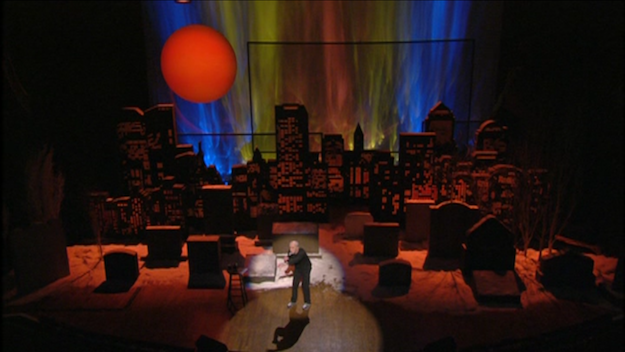
The DVD
George Carlin Commemorative Collection is a 10-disc set, packaged in a 5-tray Digipak-style case inside a box, along with a folded collectible poster of the cover art and a booklet featuring program information, photos, and a liner note essay by Patton Oswalt. The 14 main specials are presented on 5 DVDs. The bonuses are presented on the next 3 DVDs, a CD, and a Blu-ray (region A) (see Special Features below for details).
The Video & Audio:
Considering the differing vintages of these TV specials, they pretty much look and sound how you would expect. The first twelve specials are presented in standard 1.33:1, while the final two specials are widescreen 1.78:1. Most of them look suitable for their age; not crystal clear, but you can make out what's happening (i.e., it's a guy on a stage). You Are All Diseased looks a little more washed-out than one might expect, but it's not a deal-breaker. All of the programs are presented in Dolby 2.0 stereo... and they sound fine. You can always hear the jokes A-OK. All of the specials offer English subtitles. The first four specials also offer Spanish subtitles.
Special Features:
(6:16) - A black-and-white clip from 1962, in which a suit-wearing George does a number of impressions, first of other comics and then of president John F. Kennedy. That's right! Impressions!
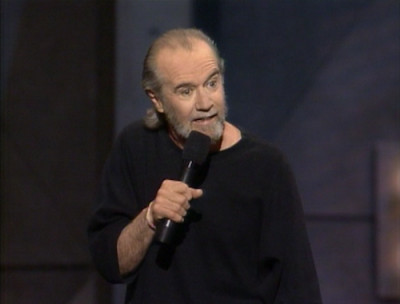
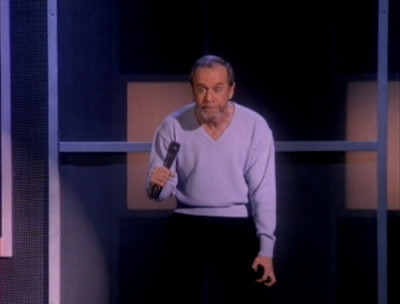
- George Carlin's Personal Favorites (59:50) - A 1996 compilation of various memorable moments from the specials, plus the 1986 Comic Relief version of "A Place for My Stuff" and a 1990 redux of "Baseball and Football." George also offers a new introduction, trying on women's hats and spitting out goofy one-liners. Includes optional English and Spanish subtitles.
- Carlin at the Comedy Store (1999) (1:05:11) - A video recording of George doing final tweaks to the hour that would become You Are All Diseased. It's interesting to see him reading some of the jokes off a collection of pages, as he tries to memorize them.
- George's Best Stuff (1:27:09) - Another "greatest hits" compilation from 1996, with some inevitable overlap with Personal Favorites and a heavy focus on the first few specials. Includes optional English subtitles.
- George on George (49:14) - An autobiographical interview with George from 2003.
- Carlin at The Comedy & Magic Club (2006) (1:08:19) - A video recording of George workshopping new material over two nights, as he starts to craft his final special, It's Bad For Ya. Some of it is not too different from what we got in the finished special, but plenty of this material didn't make the cut. And it's nice to see George's less grumpy side come out again on stage, as he talks the audience through the moments where he has to navigate between his unrehearsed written bits.
- Too Hip For the Room (30:45) - A 2007 interview with George about his career, from the Archive of American Television. Unsurprisingly, he is incredibly smart and cogent in analyzing his own work.
- I Kinda Like It When a Lotta People Die CD (56:22) - Originally released in 2016, this album compiles cassette-recorded outtakes, mostly from the special that Carlin was prepping in the days leading up to 9/11. After the terrorist attacks, there was some retooling and I Kinda Like It When a Lotta People Die became Complaints and Grievances. This material is angry and gross, and clearly of a piece with the bits that made it into the special. Also includes short interviews with Carlin collaborators Jerry Hamza and Rocco Urbisci.
- HD Versions of Life Is Worth Losing and It's Bad For Ya - The last disc in the set is a Blu-ray with both of these specials, presented in AVC-encoded 1080p 1.78:1 widescreen and with LPCM 2.0 stereo sound. The disc also duplicates two of the other included bonuses: Too Hip for the Room and the Jackie Gleason Show appearance.
Final Thoughts:
What an extraordinary set. Not only do we get all fourteen of George Carlin's HBO stand-up specials in one place, but there are also hours and hours of excellent bonus material. For Carlin fans, there is no question that this is a must-own. DVD Talk Collector Series.
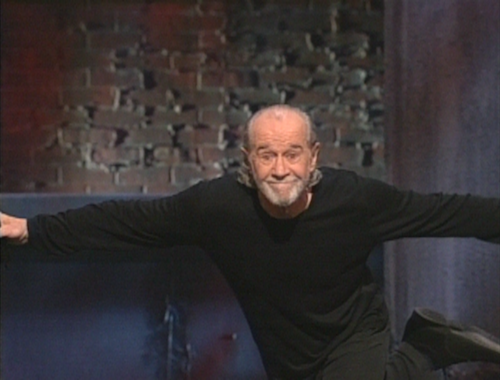
Justin Remer is a frequent wearer of beards. His new album of experimental ambient music, Joyce, is available on Bandcamp, Spotify, Apple, and wherever else fine music is enjoyed. He directed a folk-rock documentary called Making Lovers & Dollars, which is now streaming. He also can found be found online reading short stories and rambling about pop music.
|
| Popular Reviews |
| Sponsored Links |
|
|
| Sponsored Links |
|
|
| Release List | Reviews | Shop | Newsletter | Forum | DVD Giveaways | Blu-Ray | Advertise |
|
Copyright 2024 DVDTalk.com All Rights Reserved. Legal Info, Privacy Policy, Terms of Use,
Manage Preferences,
Your Privacy Choices | |||||||














